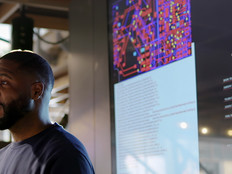Louisiana's First Post-Katrina CIO
Louisiana’s first post–Katrina CIO
Interoperability of communications for first responders is a priority for Rizwan Ahmed.
Rizwan Ahmed appointed: March 2006
Governor: Kathleen Babineaux Blanco
Previous posts: CIO for the Office of Group Benefits (OGB) and Information Technology Director for the Department of Natural Resources (DNR)
Education: Bachelor’s of Science degrees in physics and statistics and has studied at Thames University in London
Rizwan Ahmed started as Louisiana’s CIO only seven months after Hurricane Katrina ripped through the state. But taking the top technology post in the southern coastal state wasn’t an agonizing decision for him. After all, Ahmed had already served as the CIO of two major Louisiana state departments and as a key participant in the state’s efforts.
One of Ahmed’s major initiatives in his previous role as CIO of Louisiana’s Department of Natural Resources (DNR) was the well-known SONRIS project, an acronym for Strategic Online Natural Resources Information System that’s pronounced “sunrise.” In place since 1999, SONRIS is a top-to-bottom Web system that provides oil, gas and coastal protection information. Although Louisiana is abundant in natural resources such as oil and gas, the state loses 25- to 30-square miles to coastal erosion annually. Through various projects, DNR is reclaiming the land and working to preserve as much land as possible. The DNR Web site, at dnr.louisiana.gov gets about 30,000 hits a day, and more than 13 different countries access it regularly.
Ahmed recently spoke with StateTech’s Editor in Chief Lee Copeland about his vision for a coalition of southern states, interoperable communications for first responders in disasters, service-oriented architecture and what he sees coming down the telecom-
munications pike.
StateTech: How does your state CIO role differ from the agency CIO roles you had previously?
AHMED: The two departments that I used to work for, the Office of Group Benefits (OGB) and DNR, have a combined staff level of about 100 information technology people and a combined budget of $25 million to $30 million. The state CIO’s budget is between $600 million and $900 million, depending on what’s considered IT.
Some programs may be called partially IT. For example, the Medicaid process involves claims processing, which is probably total IT, since it’s behind the scenes. But the eligibility- determination process may not be considered IT because it’s a business process. We’re trying to draw a reasonable line between the business program and the IT program, but IT is entrenched in everything, so it’s not easy.
A Few Louisiana State Facts
FLOWER: Magnoli
DOG: Catahoula Leopard Dog
BIRD: Eastern Brown Pelican
INSECT: Honeybee
TREE: Bald Cypress
StateTech: What are the biggest IT challenges facing Louisiana, and what are your plans to tackle some of them?
Ahmed: Our consolidation efforts should be on the processes. In just about any public-sector environment, people are focused on doing things they have been doing for 10, 20 or 25 years. This is a rule, and therefore we should do that. They’re very robotic in that type of attitude because we’re not really a return-on-investment-based environment; we’re a service-oriented environment. So there’s no incentive for individuals to improve their processes to achieve a goal.
But in the private sector, you have to continually reinvent yourself because your boss says, “This is the amount of budget you have to reduce; this is the new product you have to produce for the market.” There’s a different dynamic between the private sector and the public sector. Although we can’t implement all the private sector processes in the public sector, we can take advantage of certain things.
For example, Louisiana is the highest natural gas producer and the second-highest oil producer in the nation. The state’s oil and gas industry has to produce monthly production reports and provide that to three entities within the state government. Why on earth is that?
If someone were to sit down and work on the problem with out-of-box thinking, we might be able to solve this. Nobody’s really focusing on it. Eventually people will see a reason for it, and legislation can be changed and rules modified to accommodate that kind of consolidation.
StateTech: Do you think there’s executive-level support for that kind of cross-agency collaboration?
Ahmed: If that kind of thing were not there, trust me, I wouldn’t even have come here. When they started talking to me, they asked me what kinds of things we needed to do. Certainly, this administration is extremely interested in improving services.
Some services have already been improved. We devised a workflow system in DNR that allows people to submit a coastal-use permit application online to many agencies. It used to be a very paper-intensive process that took months, while the people who had applied for a permit waited and waited. Now, it’s been consolidated. There’s tracking available, and applicants are informed every step of the way.
StateTech: In 2005, your state was hit by serious natural disasters such as hurricanes Katrina and Rita. What was the biggest impact on the state’s systems as a consequence of those events?
Ahmed: Before Katrina hit, the state commissioner of administration had already issued directives for all departments to create a business continuity plan immediately. But after the hurricanes hit, people realized very quickly how disruptive this kind of hurricane can be.
Most of our state agencies are in Baton Rouge — only 80 miles north of New Orleans — and not totally out of harm’s way. The three state data centers are all there, and that was our biggest challenge. As a short-term remedy, we’ve established a data replication center in Ruston, La., about 200 miles north of Baton Rouge. Most agencies are now asked to replicate their data in Ruston. That’s the first step, and we’re hoping to complete that process before the next hurricane season.
StateTech: Are you looking for funding from the federal government?
Ahmed: We’ll be looking for federal funding with a state match.
One thing that has become extremely evident during the aftermath of these hurricanes is our interoperability problem. The first responders had enormous problems. In the New Orleans area, there was no power, no phone communications, and the cellular towers were down. Responders couldn’t talk to each other. Some had a 700-megahertz system, some had a 800MHz system, others had a cellular system.
The biggest challenge with interoperability is the interaction of state and local government. The governor can ask state government entities to do things and, if the funding is available, they’ll comply. But local entities, mainly elected bodies, have their own constituents to take care of.
The governor has issued an executive order that created a statewide interoperability executive committee, which represents all the first responders throughout the state. The long-term goal is to continue with the 700MHz system, and the short-term goal is to create something that will at least allow us to communicate among the disparate systems.
StateTech: Are you making progress in that direction?
Ahmed: This is the first time that all the entities actually sat down together and talked. After the hurricanes, people realized that we really do need each other. Here comes a crew from Shreveport, La., to help during the hurricane. But if their radios can’t talk to our radios, how can they help?
StateTech: Can you give us an update on the Road Home program?
Ahmed: The Road Home program is one of the largest government programs. It not only caters to the people we are trying to encourage to come back and establish their homes and businesses where they left off, but it also injects funds into the local economy, where it is sorely needed. The program provides up to $150,000 per entity for erecting and repairing buildings.
We’ve built many safeguards so the program won’t be misused. It’s been designed as a construction-loan program. Once the application is approved, people can start drawing money from the bank as their property is being repaired or replaced. We have tried to make it very secure and also totally transparent.
The Louisiana Recovery Authority Web site, www.road21a.org, is the entry to the system, and we’re creating a portal that will allow anyone to see how much federal and state money is coming in, where it’s going, who the contractors are and what the progress is.
StateTech: Can you talk about the Gulf Coast Summit Planning Committee?
Ahmed: It ties in with the statewide Interoperability Executive Committee. We’re looking beyond Louisiana to expand that to all eight southern states because we all face the same kind of problems. At the initial stage we’ve included Louisiana, Mississippi and Alabama.
StateTech: Are there any other points or projects you want to talk about?
Ahmed: We handle the state’s telecommunications through the Office of Telecommunications Management and our data network with leased lines that we acquired from large companies. We have to lease large pipes that aren’t filled, but the state still has to pay for them. We’re going to adopt Multiprotocol Label Switching technology. We’re going to do due diligence to be sure we get good ROI on it.
StateTech: And are you attaching any cost savings to that project?
Ahmed: Absolutely. Anything we do has to have a cost savings. Here’s my motto, borrowed from a former General Electric chairman: “Customer service, employee satisfaction and cash flow.” We want to provide the best possible service to the citizens of Louisiana, we want to save money and we want to do it while we’re having fun.






